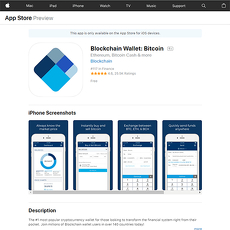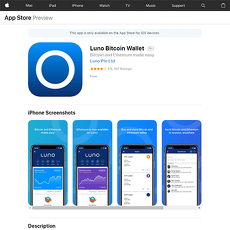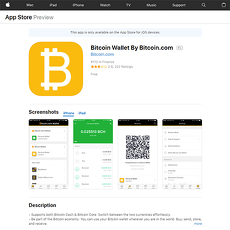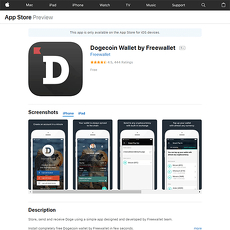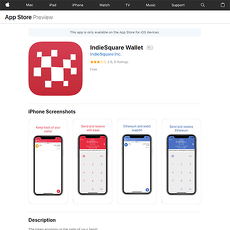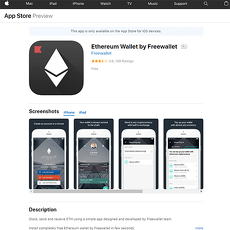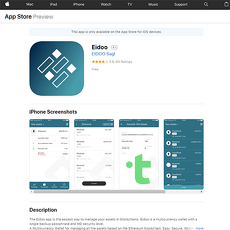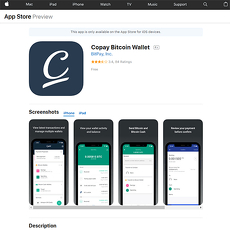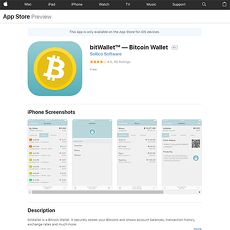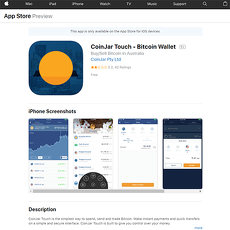WIREX:Bitcoin, Litecoin Wallet Review
WIREX:Bitcoin, Litecoin Wallet
itunes.apple.com
WIREX iOS Wallet Review (2025): Is This the Bitcoin & Litecoin App That Actually Gets It Right?
Ever stood in the App Store, staring down a long list of crypto wallet apps, wondering, “Which one lets me sleep at night… and which one’s a disaster waiting to happen?” You aren’t the only one. Wallets for Bitcoin, Litecoin, and other coins flood the store, but picking a safe, user-friendly app feels like rolling dice with your money.
Let’s get brutally honest: finding the “right” iOS wallet shouldn’t require a degree in cryptography or a survival instinct. I’ve seen firsthand people get scammed, locked out of their wallets for silly reasons, or even lose funds because the app interface was so confusing they sent coins to the wrong place. Add the constant news about hacked wallets, shady projects, and random apps disappearing from the store—no wonder most people stick to whatever is hyped on Twitter… or don’t touch crypto at all.
Why Picking the Right iOS Wallet is Actually So Tough
It’s not just FOMO or shiny features. Finding a crypto wallet you can trust with your hard-earned coins comes down to three things:
- Security: Is your crypto actually safe, or is it just one bad click away from vanishing?
- Usability: Can you send and receive coins without Googling every step?
- Flexibility: Does the wallet work for more than that one trendy coin?
Most iOS wallets either overload you with 100 useless features (hello, “innovations” no one asked for), or they cut corners on security for the sake of “simplicity.” Frankly, I’ve seen both ends of the spectrum – neither helps the everyday user survive crypto’s wild west.
Where Most Crypto Wallets Mess Things Up
After years spent reviewing wallets, I keep seeing the same headaches pop up for real folks:
- Complicated Setup: Ever try explaining seed phrases to a beginner? Half quit before they finish step 2.
- Lack of Coin Support: You download a wallet for Bitcoin…and that’s all it does. Add Litecoin or Ethereum? Sorry, try another app.
- Security “Black Boxes”: Too many wallets make big promises about safety, but give you zero info on how they actually protect your money.
- Random Freezes / Lockouts: I’ve received countless emails about “account frozen for no reason”—a nightmare when your coins are at stake.
What’s worse, the slick marketing makes it seem like every wallet is “the safest” and “the easiest.” The reality? A 2023 study from Ledger’s Security Lab showed that over 40% of top App Store crypto wallets either didn’t offer strong backup and recovery, or buried the feature so deep users missed it entirely. Imagine losing your phone…and your entire Bitcoin stack is gone forever. That’s exactly what happens to too many users.
What I Promise You in This Guide
Let’s skip the sales fluff. You aren’t here to get pitched yet another wallet “revolutionizing crypto.” You’re here because you want a wallet that works, keeps your coins protected, and doesn’t require a PhD to use.
I’ll walk you through Wirex’s real strengths and actual limitations—no sugarcoating. And when we stack it next to popular iOS wallets like Trust, Coinbase Wallet, and Exodus, you’ll get the truth: which one is best for beginners, which lets you actually control your coins, and which ones might leave you stuck if something goes wrong.
Ready to cut through the noise and find out if Wirex is the missing link between you and an easy, safe Bitcoin or Litecoin experience? In the next section, I’ll break down what Wirex really is, where it fits in the crowded wallet world, and whether it delivers the features you actually want.
Ever wondered what really sets Wirex apart—or if it’s just another wallet with a fancy logo? Stay tuned, because I’ll reveal the answers (and a few honest surprises) next!
What is Wirex and What Can It Really Do?
Picture this: a crypto wallet that lets you store Bitcoin and Litecoin, sure, but also something that wants to be your go-to for spending, swapping, earning, and actually using your coins in daily life. That’s the Wirex pitch in a nutshell. Unlike some wallets that just sit there holding your coins like a dusty piggy bank, Wirex tries to make crypto feel spendable and part of your normal financial routine.
"Technology must be usable, or it’s just clutter we carry around."
—random wisdom often repeated in the crypto world and absolutely true for mobile wallets.
Here’s what stood out (the good, the questionable, and the practical) during my hands-on experience:
How the Wirex Wallet Stands Out (or Doesn't)
When you open Wirex, you’ll notice right away it’s set up more like a neobank app than some nerdy crypto interface full of random strings. You can send, receive, and store crypto, but also:
- Buy crypto — Directly from your debit/credit card or bank transfer, right inside the app.
- Convert between assets — Instantly swap Bitcoin for Litecoin, or even for a handful of supported fiat currencies, sometimes without even leaving the screen you’re on.
- Spend using a payment card — This is where Wirex flexes: order their Visa or Mastercard, and pay for lunch or fuel straight from your crypto or traditional balance.
- Earning while you spend — “Cryptoback” rewards (usually between 0.5% and 2%), so you earn a little Bitcoin back every time you tap that card at Starbucks.
But does all of that work smooth as butter? Mostly, yes, but it’s not always as quick as Apple Pay or your usual bank app when the network hiccups. So if you’re dreaming of buying coffee every morning with Litecoin, expect an occasional awkward wait at the checkout.
Supported Coins and Features – What's in the Package?
Wirex isn’t just a “BTC & LTC only” club. Here’s a real look at what crypto and fiat you can use without testing that bottomless patience:
- Crypto: Bitcoin (BTC), Litecoin (LTC), Ethereum (ETH), and a rapidly growing batch of major altcoins (think Stellar, Nano, and sometimes new tokens from time to time).
- Fiat currencies: Multiple options depending on your region (USD, EUR, GBP, and a few others), all living side-by-side with your sats and lites.
- Other features: In-app exchange, instant notifications, and the legendary Wirex debit card integration.
Still, it’s not the one-size-fits-all paradise: want ultra-niche tokens or direct DeFi access? This isn’t Uniswap or Trust Wallet, so hardcore altcoin traders might find the menu a bit short.
User Experience and Ease of Use – Is it Friendly Enough?
If you’re new, Wirex can feel like a breath of fresh air. Setup is fast, and you’re not bombarded with puzzles and endless forms. Big buttons, a home screen that makes sense, and sending or receiving coins only takes a few taps.
However, a few quirks—like slower response times during market surges, or forced security checks when you send large amounts—can trip up even seasoned users. Still, reading through hundreds of App Store reviews, the praise keeps circling back to one thing: it’s approachable, even if crypto sometimes isn’t.
Security Layers – What’s Keeping Your Crypto Safe?
Let’s be frank: no app is bulletproof. But Wirex takes the basics seriously, and that's key. Here’s the recipe they use to keep your assets from wandering off:
- Encryption: Bank-level across the board. Every login and transaction is locked down.
- 2FA (Two-Factor Authentication): You’ll need a fingerprint or SMS code to get through the most sensitive stuff.
- Backup: If your phone takes a swim, account recovery is possible via standard email verification—no manual seed phrases, which helps newcomers but means Wirex itself holds the keys (it is custodial, so you’re trusting them).
- Constant fraud monitoring: Always running in the background—so more legit account locks than anyone really wants, but it’s for safety’s sake.
Is total self-custody your dealbreaker? Wirex doesn’t give you private keys directly. That’s both a relief for people who hate dealing with seed phrases and a red flag for hardcore decentralization fans or anyone storing life-changing amounts. If you’re looking for “not your keys, not your coins” purity, you’ll get twitchy here.
Still, for most newcomers and anyone who would otherwise just leave their coins on an exchange, Wirex is a massive step up for keeping funds secure and accessible during daily life.
But here’s the thing—no matter how slick or safe a wallet app is, the real story begins once you download and use it yourself. Wondering what actually happens the first time you set up Wirex and try sending your first crypto payment, or if there are any first-timer mistakes waiting to trip you up? Let’s peel back the curtain...
Getting Started with Wirex on iOS – Set Up & First Steps
If you’re ready to actually get hands-on with Wirex, I want your first minutes on the app to be smooth, not stressful. Let’s roll up our sleeves and make sure you set things up the smart way—because that’s where most wallet regrets start.
Step-by-Step Installation – Your Quick Start Guide
First, don’t just type “Wirex” in the App Store and tap the first thing you see. Crypto scammers love to slip fake apps onto the store—just ask the folks who lost thousands by accidentally downloading clones. Always:
- Use Wirex’s official link from their website to land on the real app page.
- Double-check the developer: it should be “Wirex Limited.” Anything else? Walk away.
After download, you’ll be guided to set up your account. Use a strong, unique password—don’t recycle something you’ve used elsewhere. When Wirex asks for your email and phone, they’re setting up your security, so don’t try to rush through. (Research from Statista shows credential-stuffing attacks on financial apps exploded by 45% last year. Small extra effort here pays off.)
Backing Up And Restoring Your Wallet – Don’t Skip This!
Some users breeze through setup and miss the backup step. That’s playing with fire. Wirex is mostly custodial, so technically, they hold your keys—not you. But your access is still linked to your phone and credentials.
- Add recovery info: Set up your backup email and make sure your phone number is confirmed.
- Enable 2FA: Use Google Authenticator or SMS for an extra lock on your account. You can turn this on right after sign-up in Settings.
If you lose your phone, you just reinstall the app, enter your login and 2FA, and recover access. But here’s a pro tip: jot down any recovery codes Wirex ever offers in a paper notebook—never just screenshot. Accidentally wipe your phone or change SIM cards, and you’ll be glad you did.
“The best time to back up your wallet was yesterday. The second best time is now.”
Funding Your Wallet – How to Add or Transfer Crypto
Let’s talk funding—because staring at an empty wallet isn’t much fun. Wirex gives you two slick options:
- Buy crypto directly: Use your debit card or Apple Pay to buy Bitcoin, Litecoin, and other supported coins right from the app. Wirex’s rates are usually competitive, but always double-check fees before confirming (their summary before payment helps spot surprises).
- Transfer crypto in: Already have coins? Hit “Add Funds,” grab your personal Wirex wallet address (triple-check—see the full address, not just the last four digits), and send from your other wallet.
Here’s a catch many forget: always send the right coin to the right address type. Sending Litecoin to a Bitcoin address—poof, it’s gone. Wirex labels these addresses clearly, but the nervous sweat is real if you rush.
Avoiding Costly Mistakes – Pro Tips From Experience
I’ve seen too many folks fall for these rookie errors. So here’s how you skip the pain:
- Copy/paste wallet addresses: Never type them out by hand. A single typo is a disaster—no undo button in crypto!
- Test with a small amount first: If you’re sending funds from another app, do a tiny “test” transaction before going big. Saves so many headaches.
- Remember your password and 2FA: Forgotten login info can take days to recover, and some users have reported being temporarily locked out if Wirex’s security flags suspicious activity (multiple reset attempts, odd locations, etc.).
- Check deposit minimums: Wirex sometimes sets minimum deposit amounts on specific coins. Sending less will leave your balance at zero—your coins don’t bounce back; they just get stuck on the blockchain.
One more reality check: customer support is good, but not magic. If you send coins to the wrong address or lose your login, recovery isn’t guaranteed. No matter how smooth you think you are, even crypto veterans have told me about million-dollar mistakes made “just once.”
Ready to see how Wirex holds up against classic names like Trust Wallet and Exodus—or if it’s really the best move for your everyday crypto? Let’s lay it all bare in the next section, so you don’t just pick safe…you pick smarter. Stay tuned, because what I’ve found in the real world might make you rethink everything.
How Does Wirex Compare to Other iOS Wallets?
Wirex vs. the Top Contenders – The Honest Comparison
If you’re anything like me, you’ve probably been through more crypto wallets than you can count, always chasing “the one.” So here’s the real talk: how does Wirex actually stack up next to fan-favorites like Trust Wallet, Coinbase Wallet, or Exodus?
- User Experience: Wirex is smooth and straightforward for basic crypto sends, receives, and payments, putting it in the same league as big names like Trust or Exodus. But there’s a twist—Wirex adds a payment card, which most wallets simply don’t offer.
- Features for Beginners: Trust Wallet and Exodus almost overwhelm you with options if you’re new. Wirex’s approach is cleaner if you’re mainly looking to manage and spend without jumping into DeFi chaos on day one.
- Advanced Goodies: Looking for staking, NFTs, or loads of coins? Trust Wallet covers more ground here. Wirex keeps the focus on major assets (Bitcoin, Litecoin, Ethereum, etc.) and lets you spend crypto in the real world—perfect if everyday utility matters more to you than trading meme coins.
One study from Statista shows that what crypto users want most in a wallet is “ease of use” and “spending flexibility.” Wirex nails this with its global card and in-app exchange, beating out competitors who just focus on storing coins. But if you’re a power user after endless customization, Trust Wallet, Coinbase, or MetaMask probably still take the cake.
"A wallet isn't just where you keep your coins—it's the door to your entire crypto experience."
What Do Real Users Like (and Complain About)?
App Store reviews are brutal and honest—which is exactly what you want. Here’s the real-world scoop from users who’ve lived with Wirex every day:
- Loves: Simple design, quick crypto swaps, and, of course, that Visa card people can use for actual purchases. Many love earning cashback (in crypto!) on normal spending.
- Pain Points: The most common complaint? Slow KYC verification or account limitations after large deposits. Some mention customer service is sometimes “hit or miss,” especially when urgent help is needed. Occasionally, app updates cause login issues (how 2020s, right?).
Wirex gets frequent 4+ star ratings, with users highlighting the “convenience of spending crypto like cash.” But, like with any custodial setup, there are trust issues—if Wirex puts accounts on hold due to compliance, access to your funds isn’t instant.
Special Perks: Wirex Card, Rewards, and Fees
Let’s talk about Wirex’s real standouts. This isn’t just a digital wallet; it’s a passport to crypto in the real world.
- Visa Debit Card: Instantly spend Bitcoin, Litecoin, or fiat at millions of stores. Starbucks run with crypto? Go for it.
- Cashback Rewards (“Cryptoback”): Get up to 8% back in WXT tokens every time you use the card. That’s like getting paid for what you already do.
- Low FX Fees: Planning to travel or shop internationally? Wirex’s interbank rates often beat even the likes of Revolut or traditional banks, making it a favorite for frequent flyers.
- Transparent Pricing…Usually: Daily crypto-to-fiat conversions are clearly shown, but do keep an eye out for minor crypto withdrawal fees and occasional ATM fees. No one likes unpleasant little surprises, right?
If you’re hunting for a wallet that rewards your spending and actually lets you use your crypto in everyday life, Wirex is a top choice. But for zero fees or completely anonymous use? It’s not for you.
Who Should Use Wirex? My Straight Opinion
If you want the power to use Bitcoin or Litecoin just like cash—whether it’s for coffee, groceries, or that spontaneous online buy—Wirex is hard to beat. Its streamlined interface means you won’t get lost, even if you’re not a crypto pro yet.
But if you’re a diehard crypto purist who insists on holding your keys, wants to trade every altcoin in existence, or can’t stand even a hint of account verification, you’ll probably crave a different wallet. Users looking for heavy DeFi, privacy, or huge lists of obscure coins still lean toward Trust or MetaMask.
Honestly, there’s no “best” wallet for everyone. It’s about finding what lines up with your real-world habits and tolerance for risk. Do you want crypto to blend into your everyday? Or sit tight as a locked-up investment?
Curious about whether you can really trust Wirex with your funds—or what happens when you need to cash out fast? Stick around… the next part answers the burning, honest questions about Wirex that most review articles skip. You’ll want to see what’s coming before putting your crypto anywhere.
Popular Questions About Wirex – FAQ & Honest Answers
Let’s face it—no matter how experienced you are in crypto, you’ll always have a few lingering questions about new wallets. I get questions about Wirex all the time, and I’ve collected the most common (and real!) ones below. Get ready for honest answers, clear explanations, and no recycled fluff.
Can You Really Trust Wirex? Safety in 2025
Is Wirex safe enough to trust with serious funds in 2025? Straight answer: Wirex is a regulated service in multiple jurisdictions and has a pretty established track record, but it’s custodial. That means Wirex, not you, holds the keys to your wallet. This can be reassuring for some (similar to how banks hold your money), but it does put a degree of trust in the company itself.
Security features include 2FA, biometric logins, and multi-sig protections. But—as recent history has shown with other platforms—even the “safest” custodial wallets are not immune to hacks. For instance, the infamous Mt. Gox and QuadrigaCX exchange stories taught everyone: don’t put more on a custodial platform than you can afford to lose.
If Wirex is ever targeted by hackers or faces regulatory trouble, you rely on their systems and insurance (if applicable). This is a good reason to keep larger stashes in non-custodial wallets where you control the keys, and leave Wirex for everyday spending or smaller balances.
How Do You Cash Out or Spend Crypto from Wirex?
Ready to turn your crypto into cash, or just use it for real-world spending? Here’s what Wirex lets you do:
- Sell Crypto for Fiat: In the Wirex app, you can convert Bitcoin or Litecoin (and other supported coins) to fiat (like USD, GBP, or EUR) with just a few taps. The balance lands right in your Wirex account’s fiat section.
- Wirex Card: Order the physical or virtual Wirex Visa card. Use it anywhere Visa is accepted—online, in-store, or even at the ATM for cash withdrawals. The app supports instant crypto-to-fiat conversion at payment time—so yes, you can literally spend your Bitcoin at Starbucks.
- Bank Transfers: Want the old-school approach? Withdraw fiat from your Wirex app straight to your linked bank account with standard wire transfer options. Processing time depends on your region but is usually within a day or two.
Pro tip: Double-check local currencies and region availability for the Wirex card—it's supported in most of Europe and parts of Asia-Pacific but not universally worldwide…yet.
What’s the Fee Situation? Are There Hidden Costs?
Crypto wallet fees are always a hot topic. Here’s what you can expect with Wirex (as of 2025—the crypto world changes fast, so always check their latest fee schedule):
- Crypto Transaction Fees: Sending crypto from Wirex to another wallet? You pay a network fee (which goes to miners) and potentially a small service fee. These are always shown in the app before you hit “send.”
- Conversion Fees: Swapping crypto to fiat or vice versa comes with a spread—Wirex’s rates are competitive but not always the absolute lowest. Typically, you’ll see about a 1% fee on crypto exchanges, though this fluctuates with the market.
- Card Fees & ATM Withdrawals: The Wirex card is free to order in some regions (otherwise, there may be a small delivery fee). ATM withdrawals incur a set flat fee—most recently $2.50/€2.25 per withdrawal—but check the app for your region. International card purchases may attract a small FX rate fee as well.
- Hidden Fees: I haven’t found any sneaky hidden fees, but always read the fine print—some users report small charges for inactivity or less-common actions, depending on location.
Hot tip: Activate price alerts to watch market swings so you don’t get caught converting crypto when network fees spike (e.g., when the whole blockchain is crowded).
What Happens if You Need Help? Support and Customer Service
Even the smoothest wallet can glitch or confuse you—especially when real money is on the line. Wirex offers 24/7 chat-based support, but it’s largely bot-driven at first, followed up by a human if you flag your issue as unresolved.
What’s the verdict from real users? Many report fast responses for simple issues (like logging in or resetting details). However, I do see ongoing complaints about slow ticket resolutions, especially for complex topics like verification delays, frozen accounts, or card-related glitches. Patience (and clear communication) is your best bet if you hit a rare snag.
If you want a sneak peek at user experiences, skimming recent App Store reviews tells the full story—from delighted first-timers to frustrated power users. Transparency: not every wallet is perfect, and it pays to have screenshots and transaction info ready before reaching out for help.
Extra Resource: Where to Learn More and Compare Wallets Quickly
Thinking about comparing Wirex side by side with other top iOS crypto wallets? Don’t reinvent the wheel.
- Ultimate Guide to Best iOS Bitcoin Wallet and Altcoin Wallets: Everything You Need to Know with FAQ — This resource lays out direct wallet comparisons, feature breakdowns, security overviews, user feedback, and the latest must-know updates. It’s my hands-down favorite library for dissecting the top wallets in one place (and yes, it’s getting updates all the time).
- Cryptolinks.com — Stay on the pulse! If you want wallet reviews, fresh user tips, or to be alerted when there are new scams, this news feed keeps you one step ahead.
When you’re picking between Wirex, Coinbase Wallet, Trust Wallet, or anything in between, having the right info—backed by real tests—makes your choice 10x easier.
Still got questions? Good—you should! Having doubts is wise in crypto. But if you want my personal verdict on whether Wirex is the wallet for YOU, or what you should do before sending any significant funds, don’t miss the next part—because I’m about to get brutally honest (with zero hype). Stick around—you’re closer than ever to getting this wallet thing right.
Should You Use Wirex for Your Crypto in 2025? My Final Verdict
What Really Matters – Wrapping Up the Pros and Cons
So, is Wirex worth trusting with your Bitcoin, Litecoin, or whatever coin you’re stacking in 2025? Here’s the honest scoop, straight from real-world testing—no fluff, just what actually matters when your cash is on the line.
- Strong points? Wirex genuinely shines for everyday crypto use. Their app is simple to figure out (even if you’re not a techie), and storing, spending, or swapping your crypto just makes sense. Being able to grab a Wirex Visa card and tap-to-pay in shops is more useful than “yet another hardware wallet collecting dust.”
- Where does it lag? Here’s where things aren’t perfect. Wirex is a custodial wallet—meaning you’re trusting them to store your coins, not holding your own keys. Users looking for 100% self-custody may want to have a second wallet as backup (something I always recommend for large HODL amounts). Fees are competitive but sometimes a little sneaky on exchanges and card conversions, which some App Store reviewers point out.
- Is it secure? I haven’t found any data breaches in the last few years, and Wirex is regulated in multiple regions. Still, you’re only as strong as your password and 2FA game. If you ever get lazy, even the best security team in the world can’t save you.
- User pain points? Honestly, support can be spotty during a crazy market rush. Some folks report KYC/verification delays, which can be a headache if you’re not prepared (don’t leave cash-outs to the last minute!).
For me, Wirex stands out as a seriously useful wallet if you want to spend and store crypto like regular money, not just stash it and forget it. But if you’re all about privacy, never giving up your private keys, or you love the open-source world, you’ll want to keep exploring. Think of Wirex as a good “daily driver” wallet, not your secret long-term vault.
What to Do Next – Smart Steps Before You Commit
Before you trust any wallet with your main stash, here’s what I always do:
- Test with a small amount—send $5 or $10 first. Try sending, receiving, and spending crypto to see if anything feels off.
- Set up backups right away. Even though Wirex is custodial, use every 2FA option available. Write down recovery codes if given.
- Try at least one other wallet. I recommend always having a second, non-custodial wallet on hand (like Trust or Exodus) so you’re never stuck if something goes wrong, or if you want more privacy and control.
Don’t get stuck in analysis paralysis. A little testing goes a long way—apps feel and work differently for everyone.
Bonus Tips: Staying Safe and Getting the Most Out of Your Wallet
- Security habits are everything. Use unique passwords (password managers are lifesavers) and always enable 2FA. Way too many hacked accounts start with re-used, lazy passwords.
- Get those rewards. If you grab a Wirex card, don’t forget to turn on crypto cashback and track spending in the app. Bonuses and savings stack up faster than you think—especially if you’re using crypto for daily stuff.
- Double-check fees and limits. Especially for ATM withdrawals and foreign transactions. I’ve seen people lose out because they ignore the small print.
- Keep learning. Crypto moves fast. Stay curious and always check for new wallet features, bug reports, or changes in fee policies.
“Never put all your coins in one basket, no matter how many influencers or sites rave about a wallet. Test, compare, and trust your gut.”
Still Have Questions? Where to Go Now
Still feeling unsure or want to check out even more options? There’s always more to research, but you don’t have to go it alone. For quick wallet comparisons, honest reviews, and new guides every week, bookmark Cryptolinks.com/news. I always post the latest wallet hacks, updates, and alerts. Got questions? Leave a comment or browse the FAQ—I actually read them!
Your crypto choices just got simpler. Stick around, and let’s keep making crypto easy (and safe) together.



